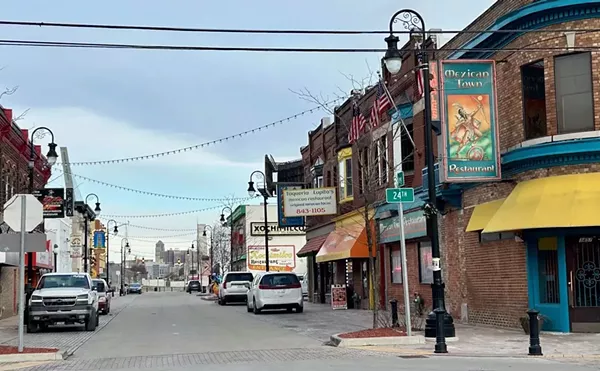Untold gallons of ink have already been spilled regarding former Gov. Engler’s recent New Year’s Eve “surprise,” a stunning veto of the long-in-the-making regional transportation bill intended to get metro Detroit on the rocky road toward a transit system that may one day exceed Third World standards.
An unapologetic Engler spurned the Detroit area by vetoing the transit legislation. This placed in jeopardy $500,000 in previously approved federal funds, as well as the less tangible, but equally important belief that the residents of this pothole-riddled metropolis may one day be able to leave the autos at home, like, um, people in real cities do.
The basis for Engler’s veto was the failure of the state Senate to pass his eleventh-hour proposal to create up to 15 new charter schools in Detroit. In a baffling quid pro quo that must exist solely in a lonely corner of the ex-governor’s mind, the failure to pass the charter school bill obviously mandated a veto on the transit bill.
Be that as it may, the goal of this column is not to excoriate private citizen Engler, but rather to look at the flip side of the coin, at the practical reality of what happens in a downtown with substandard transit. Despite what any earnest city official will tell you, this is not a “world-class city” and will never be one until it gets a transit system worthy of that title. Our current fleet of buses and downtown trolleys falls well short of that title.
One of the byproducts of this transitless system is the continuing construction of parking structures, with hundreds of millions of dollars being devoted to structures which some development officials have characterized as “temporary” at best.
Although the Compuware headquarters gets all the photo ops, there is just as much construction going on around it, both above and below ground, and all of it devoted to parking.
Compuware has created a monstrous behemoth, a 12-story, 2,700-space structure, at an estimated cost of $40 million, so its employees can drive their cars to work.
Immediately next door, in the former sub-basement of the Hudson’s building, the Premier Garage still awaits its premiere, delayed ever so slightly from April of last year, at an estimated cost of at least $57 million (not including the Hudson’s implosion bill). Repeated requests for comment from Ron Ruffin, head of the Municipal Parking Authority of Detroit, regarding the Premier have gone unanswered.
Just across the street, the Kennedy Square parking garage hopes to open for the auto show, at an estimated cost of $25 million.
General Motors, in one of the highlights of the ballyhooed River East development on the Detroit River, announced it would devote at least $40 million to new parking structures, in addition to the 10-story structure built two years ago.
The Downtown Development Authority has also announced plans to finance a $20 million, 1,000-space garage east of the Ren Cen to help serve the estimated 1,500 EDS employees moving downtown.
Other private operations such as the Gem and the Detroit Athletic Club have had to add another 1,000 spaces between them at a total cost of at least $12 million.
Another mammoth structure opened this spring behind One Detroit Center, a space initially slated for a companion tower to architect Philip Johnson’s neighboring neo-gothic skyscraper.
Even the Detroit Opera House is getting into the act, recently announcing plans to rebuild its five-story structure at a cost of at least $16 million.
In the face of this thriving garage-construction industry, an even more regrettable byproduct of this transit-deficient city is the thriving trade in surface parking lots, where old buildings are pulled down and graded over while enterprising hucksters wave you in off the street to navigate your soon-to-be-door-dinged car into a sardine can of a lot. While the capital costs of these lots are considerably less than the hundreds of millions referenced above, the aesthetic decimation of our streetscape and pedestrian isolation they engender is an irrefutable blight on our downtown.
In some ways, downtown Detroit has effectively taken on a disposable quality to serve the parking demands of the metropolis.
According to Ron Flies, of the Detroit Economic Growth Corporation, the parking structures are not inherently bad, but simply “temporary uses on a site,” and can generate revenue until something better comes along. Flies, however, believes that “transit is only successful when there is a concentrated development it can serve,” and, aside from the chicken-and-the-egg dilemma inherent in his analysis, the plethora of parking lots and massive structures is apparently more a result of depressed real estate values than anything else.
In any event, the above “disposable” projects, at a minimum, are coming in at $230 million and counting.
And city officials estimate that there will be a need for an additional 5,000 spaces in the near future (costing an additional $60 million to $75 million under the general rule of $12,000 to $15,000 per space).
Until this region makes progress on a coordinated transit system that people will actually use, downtown Detroit will continue to labor under the necessary evil of idling away in choking traffic and strolling under the shadows of the hulking parking structures dotting the downtown landscape.
Moreover, the state intends to devote $1.3 billion to widening 6.7 miles of I-94 to create a swath through downtown large enough for 24 lanes.
One can easily think of better ways to spend that $1.3 billion, particularly when you also factor in the aforementioned hundreds of millions of dollars being spent on parking construction.
According to data from the Southeast Michigan Council of Governments, a modern commuter line from Detroit to Pontiac would offer an alternate to I-75 commuters who use I-94 to access areas of central Detroit, and would cost about $200 million. The oft-discussed designated rapid transit bus lines, aka SpeedLink, running along Gratiot to Eastland, Grand River to the city limits and Michigan to Dearborn, consisting of about 32 miles, would cost about $385 million.
By way of further contrast, Minneapolis is close to completing a regional light rail system at a cost of $675 million.
We’re spending $1.3 billion to widen I-94, and $300 million on parking garages.
When considering the world-class city designation, one could posit the question as to what a visiting journalist, in town from Geneva to cover the auto show, would be more impressed with: $300 million worth of parking garages and a widened 6.7-mile stretch of I-94 through downtown; or rapid bus services and light rail lines capable of whisking them in and around the entire region?
Casey Coston writes about development in Detroit. E-mail him at [email protected]





